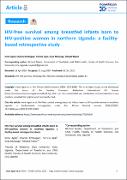| dc.contributor.author | Aguti, Irene | |
| dc.contributor.author | Kimbugwe, Charles | |
| dc.contributor.author | Apai, Patricia | |
| dc.contributor.author | Munyaga, Siraji | |
| dc.contributor.author | Nyeko, Richard | |
| dc.date.accessioned | 2021-08-09T08:09:07Z | |
| dc.date.available | 2021-08-09T08:09:07Z | |
| dc.date.issued | 2020 | |
| dc.identifier.citation | Aguti, I., Kimbugwe, C., Apai, P., Munyaga, S., & Nyeko, R. (2020). HIV-free survival among breastfed infants born to HIV-positive women in northern Uganda: a facility-based retrospective study. The Pan African Medical Journal, 37. | en_US |
| dc.identifier.issn | 1937-8688 | |
| dc.identifier.uri | https://hdl.handle.net/123456789/311 | |
| dc.description.abstract | Introduction: the HIV-free survival rate is the gold-standard measure of the effectiveness of interventions towards prevention of mother-to-child transmission of HIV in any setting. However, data on HIV-free survival among the HIV-exposed infants followed up in most low-resource settings are lacking. We determined the HIV-free survival among breastfed infants in two tertiary facilities in a resource-poor setting in northern Uganda. Methods: we conducted a retrospective cohort study in May 2019 and retrospectively reviewed records of HIV-exposed infants registered in 2014 through 2016 at two tertiary facilities in northern Uganda. We analyzed data using SPSS v16 software package. The chi-square and Student t-tests were used to compare factors among infant groups. Multivariate logistic regression analysis was used to determine factors independently associated with HIV-free survival. P-value <0.05 was considered for statistical significance. Results: majority of the infants were males 55.6% (203/365) and 98.6% (360/365) received nevirapine prophylaxis. A total of 345 (94.5%) infants were exclusively breastfed, only 100/345 (29.0%) of whom were exclusively breastfed for at least 6 months, while the breastfeeding status of 44/345 (12.8 %) infants could not be ascertained. The overall HIV-free survival rate was 93.7% (342/365), while 2.7% (10/365) were HIV-infected and 3.6% (13/365) died. Infants´ age at enrolment in care (aOR 5.20, p=0.008) and treatment facility (aOR 3.76, p=0.027) were the independent determinants of HIV-free survival. Conclusion: the HIV-free survival rate among the breastfed infants in the study setting marginally falls short of the recommended standard, thus calling for more efforts to improve survival. | en_US |
| dc.language.iso | en | en_US |
| dc.publisher | Pan African Medical Journal | en_US |
| dc.subject | HIV-free survival | en_US |
| dc.subject | Mortality | en_US |
| dc.subject | HIV-infection | en_US |
| dc.subject | Infants | en_US |
| dc.subject | Breastfeeding | en_US |
| dc.subject | Option B+ | en_US |
| dc.title | HIV-free survival among breastfed infants born to HIV-positive women in northern Uganda: a facility-based retrospective study | en_US |
| dc.type | Article | en_US |

